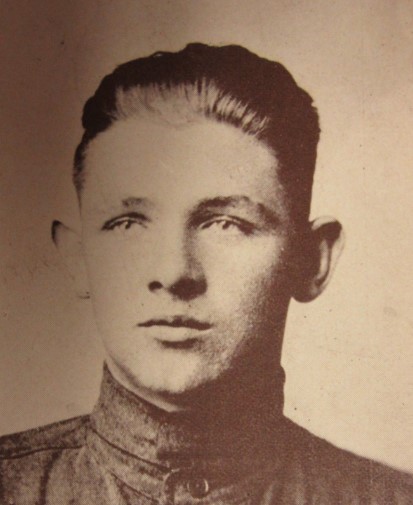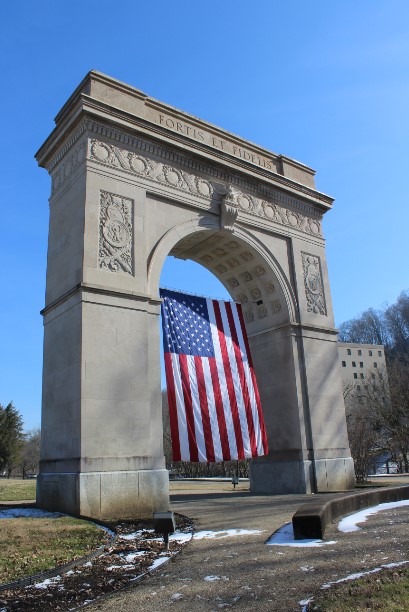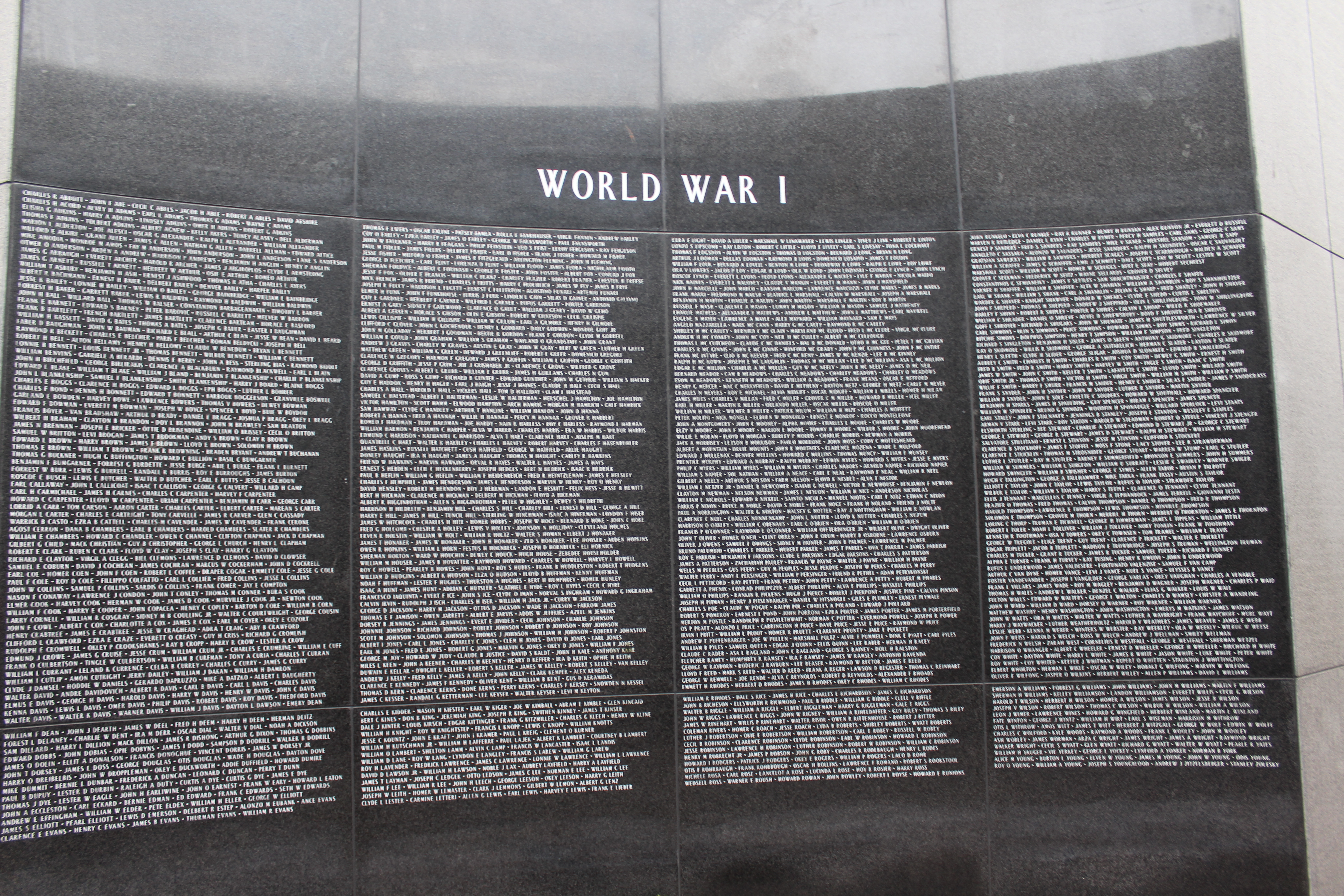Corporal Leroy Ferguson

- Unit: 32nd Division, 128th Infantry, Company K
- Date of Birth: January 24, 1897
- Entered the Military: April 2, 1917
- Date of Death: June 6, 1918
- Hometown: Huntington, West Virginia
- Place of Death: near Peuvillers, France
- Cemetery: Plot D, Row 21, Grave 28. Meuse-Argonne American Cemetery, Romagne-Sous-Montfaucon, France
Ripley High School
2018-2019
Early Life
Leroy Ferguson was the son of Mordecai Daniel Ferguson and Mary Polly Ferguson. He was born on January 24, 1897 in Huntington, West Virginia. His father was a painter and his mother was a homemaker.
Ferguson had an older sister, Otsie Marie, who was born around 1891. Otsie worked for the railway steam industry as a hostler, tending and caring for horses. The family’s cousin, Alec, lived with them according to the 1920 U.S. census. When he enlisted in the military at age 20, he was unmarried.
Military Experience
Ferguson entered service in the West Virginia National Guard on April 2, 1917. A month later, he was assigned to the 2nd West Virginia Infantry, Company G. The U.S. Army sent him to Camp Shelby in Hattiesburg, Mississippi for training. Here, he trained in hot and humid temperatures, especially as compared to the more mild climate of West Virginia at that time of the year. At Camp Shelby, Ferguson’s unit was absorbed into the 38th Division, 150th Infantry Regiment. He continued his training at Camp Shelby for roughly ten months.
After training, Leroy boarded the SS Grampian and departed from New York City for Europe on June 11, 1918. Once overseas, he was first assigned to 41st Division, 162nd Infantry Regiment, Company L. Only four months later, on September 5, 1918, Ferguson transferred to the 32nd Division, 128th Infantry Regiment,Company K.
Upon arriving in France, the soldiers went through more training, which consisted of trench warfare tactics including firing weapons and artillery practice. By January 1918, the 32nd Division had made their way to Brest, France on the western coast. This division joined the American Expeditionary Force (AEF) as a replacement with about 150 men per company. Ferguson served in the 32nd Division, 128th Infantry Regiment starting on September 5, 1918. Two days later, he received a promotion. The 32nd Division was comprised mostly of men from Wisconsin and Michigan, though there were some from West Virginia and other states. The 32nd Division is best known for being the first to set foot on German soil on May 18, 1918, and for their successful offensives in the Aisne-Marne, Oise-Aisne, and Meuse-Argonne campaigns.
The 128th Infantry Regiment, Company K traveled east, headed towards Juvigny, France. Along the way, the company served in Verdun from September 23 to 25. The unit moved front line to relieve the 91st Division, and by October 4, Ferguson and his company were on the front of the Bois de la Moraine. From there, they marched through the woods, along with support from the 127th Infantry Regiment. On October 5, the 128th Infantry Regiment relieved the 127th Infantry Regiment . They next day they entered active combat on the front lines. Those last days of conflict were undoubtedly brutal for Ferguson as well for the rest of the men in his brigade. During the next two days, they pushed forward through obstacles until the 128th Infantry Regiment successfully removed the German troops from that region.
On October 6, 1918, Ferguson was killed in action from enemy artillery fire on a battlefield near Peuvillers, France. Sergeant Achille Ganguet from Albany, New York witnessed his death during the battle.
.jpg)
.jpg)
.jpg)
Eulogy
Word of his death took several weeks to reach his parents as they had moved during his time overseas. The Logan Democrat published an article in the paper called, “Father Learns Holden Boy Was Killed in Service.”
Ferguson’s parents declined to make a pilgrimage to Europe to see his grave as they were in ill health. His father wrote these words to the War Department about his son, “We are proud of our boy, and feel that, as sadly as we shall always miss him, he died a glorious death in the cause of humanity for which his country was fighting.”
The state of West Virginia honored Ferguson at two locations. The West Virginia Capitol has a memorial for all those from the state who made the ultimate sacrifice. Ferguson’s name also appears on the World War I Arch in Huntington’s Ritter Park which commemorates the service of those from Cabell County. Leroy Ferguson was laid to rest at the Meuse-Argonne American Cemetery in Romagne-Sous-Montfaucon, France.



Reflection
Bibliography
32nd Division; Records of Combat Divisions, 1917-1919, Records of the American Expeditionary Forces (World War I), Record Group 120 (Box 25); National Archives at College Park, College Park, MD.
American Battle Monuments Commission. American Armies and Battlefields in Europe: A History, Guide, and Reference Book. United States Printing Office, 1938.
Center of Military History United States Army. Order of Battle of the United States Land Forces in the World War, American Expeditionary Forces: Divisions Volume 2. Washington D.C.: U.S. Government Printing Office, 1931.
Center of Military History United States Army. United States Army in the World War, 1917-1919. Washington, D.C.: U.S. Government Printing Office, 1948.
“Father Learns Holden Boy Was Killed in Action.” The Logan Democrat, December 19, 1918.
“Ferguson, LeRoy.” Cabell County World War I Memorial Boulevard. Accessed December 12, 2018. cabellwwi.wordpress.com/soldiers/dedication-list/ferguson-leroy/.
Hanson, Corporal Allen. Advanced dressing station, the farthest point…near Juvigny, France. Photograph. September 1, 1918. National Archives and Records Administration (111-SC-21913-ac). Image.
Ibid. Men of 128th Regiment 32nd. Division stringing barbed wire…Austerlitz, Alsace, Germany. Photograph. June 4, 1918. National Archives and Records Administration (111-SC-15957-ac). Image.
Ibid. Men of CO. K. 128th Regiment. Infantry on Valpries farm while in support during drive on Juvigny. Valpries farm near Juvigny, France. Photograph. August 29, 1918. National Archives and Records Administration (111-SC-21908-ac). Image.
“Honoring Our Veterans.” Cabell Record, March 6, 2003.
Joint War History Commissions of Michigan and Wisconsin. The 32nd Division in the World War, 1917 – 1919. Madison: War History Commission, 1920. babel.hathitrust.org/cgi/pt?id=loc.ark:/13960/t9183sx1k&view=1up&seq=11.
“Leroy Ferguson.” American Battle Monuments Commission. Accessed January 18, 2019. www.abmc.gov/node/332326#.WPkjf4grLIV.5.
“Leroy Ferguson.” American Soldiers of World War I. Digital Records. ancestry.com.
“Leroy Ferguson.” U.S. Army Transport Service, Passenger Lists, 1910-1939. Digital Images. ancestry.com.
“Leroy Ferguson.” U.S. City Directories, 1822-1995. Digital Images. ancestry.com.
“Leroy Ferguson.” U.S. World War I Troop Transport Ships, 1918-1919. Digital Images. ancestry.com.
Leroy Ferguson World War I Burial Case File; Correspondence, Reports, Telegrams, Applications and Other Papers relating to Burials of Service Personnel, Records of the Quartermaster General’s Office, 1915-1935, Record Group 92; National Archives and Records Administration – St. Louis.
Smith, Wiatt. Honor Roll: Cabell County, An Illustrated Historical and Biographical Record of Cabell County’s Part in the World War. Chicago: Severinghaus Printing Company, 1920.
War Diaries (32nd Division); Records of the American Expeditionary Forces (World War I), Record Group 120 (Box 2738); National Archives at College Park, College Park, MD.
West Virginia. Logan County. 1920 U.S. Census. Digital Images. ancestry.com.
West Virginia Memory Project. West Virginia Veterans Database Record Detail, 1609, West Virginia Department of Arts, Culture, and History.
“World War I Service Records.” West Virginia Archives, Charleston.

